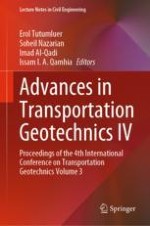2022 | Buch
Advances in Transportation Geotechnics IV
Proceedings of the 4th International Conference on Transportation Geotechnics Volume 3
herausgegeben von: Prof. Erol Tutumluer, Prof. Soheil Nazarian, Dr. Imad Al-Qadi, Dr. Issam I.A. Qamhia
Verlag: Springer International Publishing
Buchreihe : Lecture Notes in Civil Engineering
